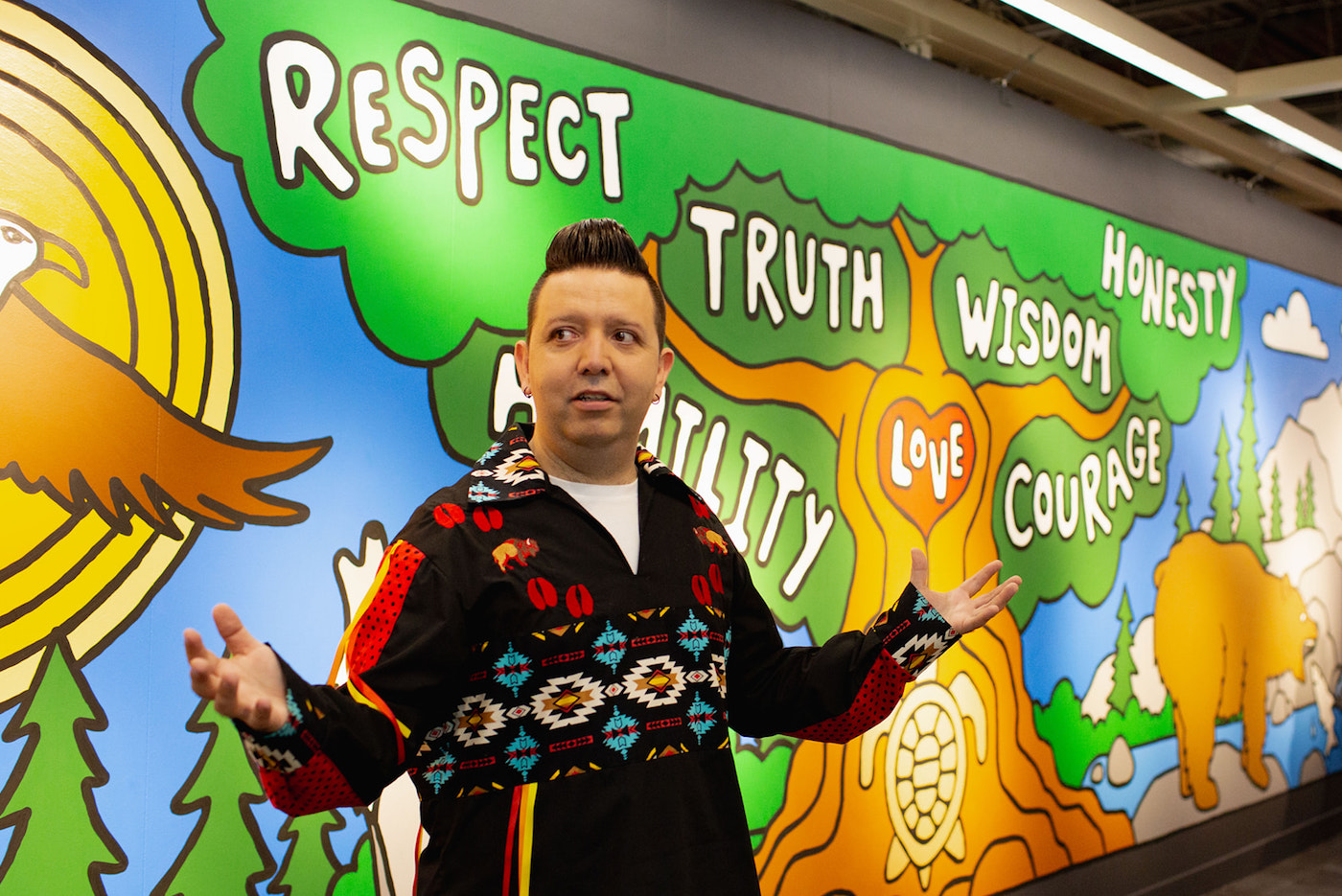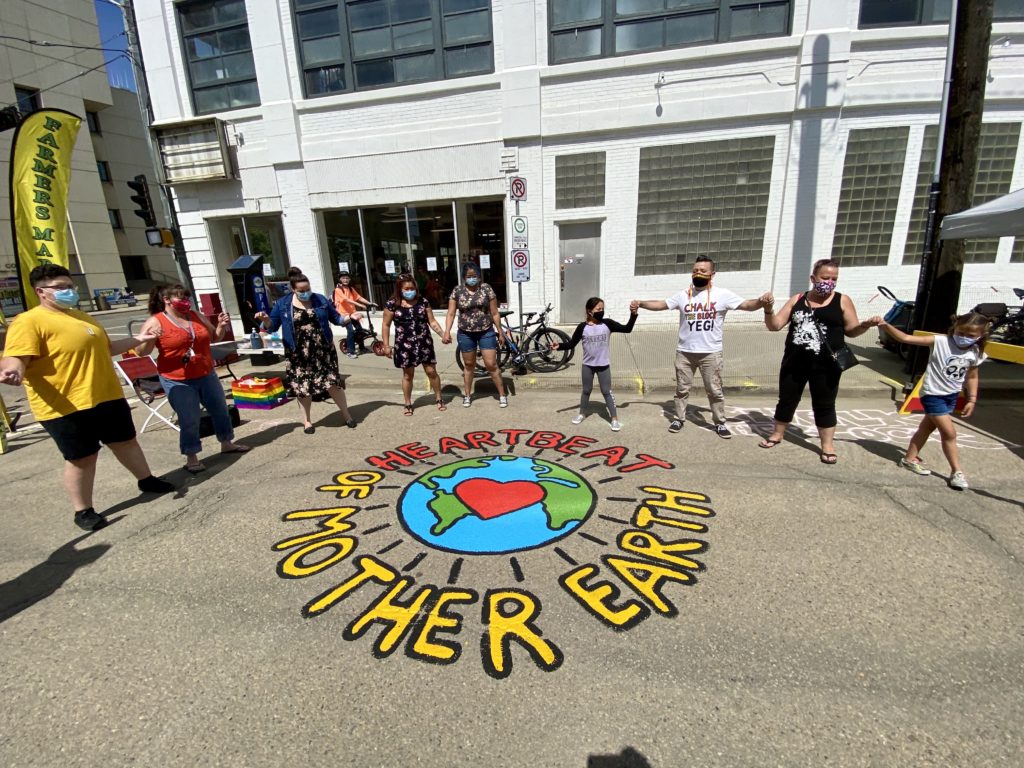
Originally from Calling Lake, Alberta, the Indigenous artist, designer, producer, choreographer and teacher Lance Cardinal has moved back to Edmonton two years ago when he was invited to be the new morning show host at the local CFWE Indigenous Radio Station. Cardinal is a member of the Treaty 8 Bigstone Cree Nation, and through his work, he strives to share his culture and knowledge with the audiences across Alberta, and beyond.
Currently, he is working on a new original musical based on the “Idle No More” Indigenous rights movement, featuring the music of Buffy Sainte Marie, and also acts as a facilitator of the Calling Lake Blanket Exercise Group, as well as works as an Indigenous Program Advisor with Fort Edmonton Park.
We spoke with Cardinal about the 40-foot-long (12-metre) Indigenous mural he painted last month, that’s now on display at the IKEA store in South Edmonton Common, his participation in #ChalkTheBlockYEG street art campaign, and creating the interactive and informative online art series for kids amidst the COVID-19 pandemic.
How was the idea for the mural at the IKEA store developed?
Cardinal: So when IKEA approached me about the idea of doing a mural, they really wanted something that represented the Indigenous people at the local territory, which was the Treaty 6 territory. And we were thinking about what that meant, and what visually could represent the nations. And then we came to another idea that it would be more important to represent the ideals of the nations and the things that we use as Indigenous people, to bring us together.
So we looked at the idea of the Seven Sacred Grandfather Teachings because these are our mantras, the things that we look at in nature, how the animals behave in Mother Nature, their relationship with each other and with the Earth, and it is how we, as Indigenous people, look at ourselves and each other, how we interact with the earth in a positive and healthy way. So we thought it would be a great chance to create a piece that would talk about those ideas, things that encourage a better way of understanding and interacting with each other, and more importantly, a more accessible way to understand Indigenous ideals in a fun and exciting way.

Can you tell us more about the Seven Grandfather Teachings and which ones do the animals in the painting represent?
Cardinal: I think a lot of these teachings like humility, honesty, respect, those kinds of things, are important for us right now. Let’s talk about how we are looking at the world, especially during the COVID situation, especially now because we’re trying to find ways to get back into the normal society, and to reintegrate into the mainstream. And I think one of the most important teachings is the love teaching, which is represented by the eagle. The reason that the eagle is so important, is because it’s the closest to the Creator. And he carries all of the teachings in his feathers, in his wings. And that’s why the eagle feather is such a sacred honour for us. When we find an eagle feather, we are honoured by that feather and we use that feather to give to other people as a form of celebration. So that’s one of my favourite teachings, as well as the teaching of the buffalo, which is respect, because he has decided out of respect to the cycle of life, and the respect for us as human beings, to sacrifice himself fully, to the survival of human beings. We use the entire animal – we use the fur, the meat, the horns and the bones.
Now, the beaver of course, represents intellectual wisdom, because he is more of an environmentalist. He recycles the Earth in a lot of different ways. He filters the water with his beaver dam and creates these amazing structures that are one of the strongest structures in the world, which is a dome structure. And he’s efficient, he is sustainable and takes care of his family. So he is one of the smartest animals and that’s why he is the carrier of wisdom.
You mentioned that this mural and what it represents is more important now than ever, with the conversations about the systematic racism currently in the forefront. How does the concept of the mural and the Seven Teachings reflect this?
Cardinal: I think that right now, we all have been in hiding for so long. We’ve been hiding away from the pandemic, COVID-19 has kept us all at home and away from other people. And we’ve had a lot of fears and anxieties — losing our jobs and money, not being able to be with our loved ones and, in some cases, actually losing some of our family members to this disease. And I think that we’ve also lost a little bit of connection to human beings, and what it means to be spiritually and intellectually connected to other people. So as this pandemic slows down a little bit and we’re slowly introduced back into society, I think that we need to focus more on these ideals of human interaction. And I think a lot of people are feeling an awakening that’s happening right now. Because we had all these fears and lost a lot of things during this pandemic, our priorities have changed, what we think is important is different now. Family has become way more important. The people we love have become more important. Spending quality time doing things that make us feel good are way more important now. So I think these Seven Grandfather Teachings remind us of those things, how to be humble and to be courageous enough to get out there, meet new people, and try to understand other people.
And, even right now, with the Black Lives Matter movement that’s happening, as Indigenous people we are in alliance with that, we walk side by side with all the people in the Black Lives Matter movement as supporters and people who understand what it’s like to be the oppressed people. So these kinds of teachings are a reminder for us, even as Indigenous people, on what is more important than the superficial things, which is connection. Being brave enough to understand somebody else, having love in our hearts enough to reach out to other people, and connect again in an alliance and in this movement that’s happening around the world.
How long did it take you to complete the mural?
Cardinal: The mural took approximately 10 days to complete from the beginning to end. It was a very short process, eight hours a day for 10 days. But it was really amazing because as I worked on the piece, the guests in the store, and even some people who worked there, had a chance to talk to me and express how amazing it was to see this kind of indigenous representation happening in Edmonton. And especially as we sit on the Treaty 6 territory and the store itself is on Treaty 6 territory. A lot of people were saying that it was nice to have that acknowledged, that we are on Indigenous land here in Edmonton. And representing us in a very prominent location in the store was very important to me, and it was very important to everybody else at this time.
And they said, “Yes, we agree with this, we support the idea of bringing more positive light to Indigenous community here in Edmonton, and to raise the awareness of other elements to Indigenous people that we might not know already.” And that’s the whole point of this space at IKEA. The Indigenous people’s gallery at IKEA is a place of understanding, education, and unity. And the whole point of the space is to bring people in, to learn about us, to have more understanding of who we are as people, especially here in Canada.
This past weekend, you have participated in the #ChalkTheBlockYEG campaign, designed to bring more art to the streets and show support for Edmonton communities. How did you get involved with the campaign?
Cardinal: The YEG Downtown Collaboration, they saw my work online, and that IKEA mural of course, and they reached out to me and asked if I’d be willing to come to one of their #ChalkTheBlockYEG events at the Downtown Farmers’ Market. and I love the Downtown Farmers’ Market and they have an amazing Indigenous Artists Collective that happens there. And I was very happy to be a part of it and to come celebrate positive ways to get back into society during the COVID situation. And this was great because it’s about bringing people together. And that’s something that I’m so interested in, finding ways to use my Indigenous culture and my creative experiences to bring people together in a positive way.
The mural that you painted for the campaign was the globe, surrounded by the words ‘Heartbeat of Mother Earth.’ Why did you choose to paint this?
Cardinal: It’s the beat of our Indigenous drum is what we call the Heartbeat of Mother Earth because it does sound like the heart beating when we are in the womb of our mothers. So when we beat the drum, we are accessing the planet, and we are synching ourselves with the heartbeat of the planet. And I thought that was a really great thing to bring to the #ChalkTheBlockYEG. And it was awesome, because at the end when the piece was completed, we gathered around in a socially distant circle and we did a round dance around the piece to celebrate the coming together of people and it was a very diverse group of people – Indigenous and non-Indigenous people united together in a circle and dancing around the mural.
How have you been adjusting to the COVID-19 pandemic and what have you been working on at this time?
Cardinal: When the quarantine first started, I decided that I wanted to do something to entertain the kids who are stuck at home with their parents and have nothing to do. So I decided to start my own Indigenous art series called Family Art Adventures with Lance Cardinal. And it was a weekend show, a live broadcast on Saturday mornings. Basically, it was an hour-long show where I lead families, as a group, parents, and kids and guardians, whoever was in the home, through an art project with things they could find in their own house, without having to go out anywhere. And then I’d lead them through a fun interactive art project, as well as include teachings of some of my language, singing some of my songs, and even talking every week about different Indigenous artists in Alberta, and really trying to share my culture in a positive way to anyone, any nation who wants to watch, and that was really well received. I finished 12 episodes and they’re all on my YouTube channel. We’ll be starting again in the fall when school begins.







